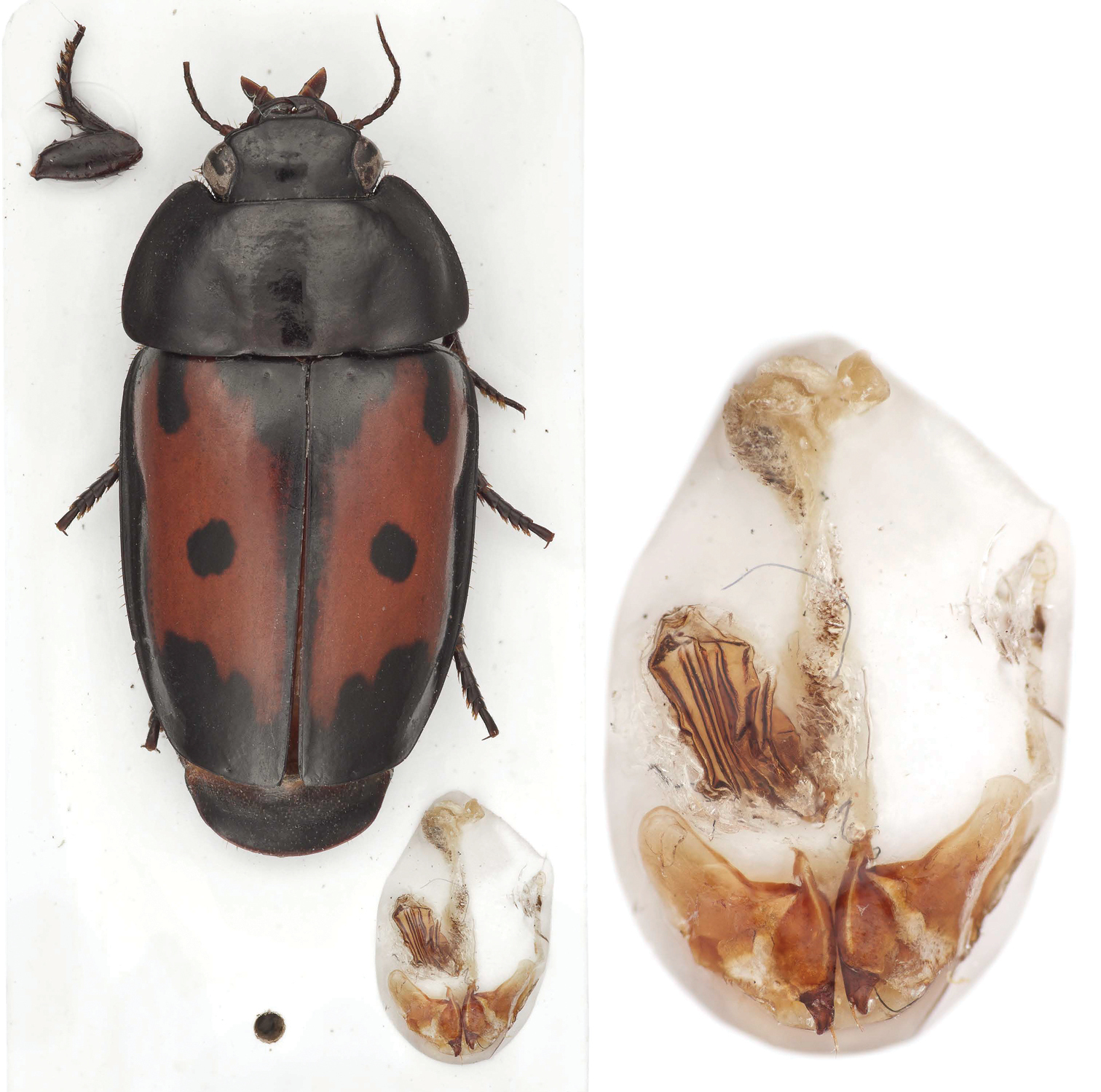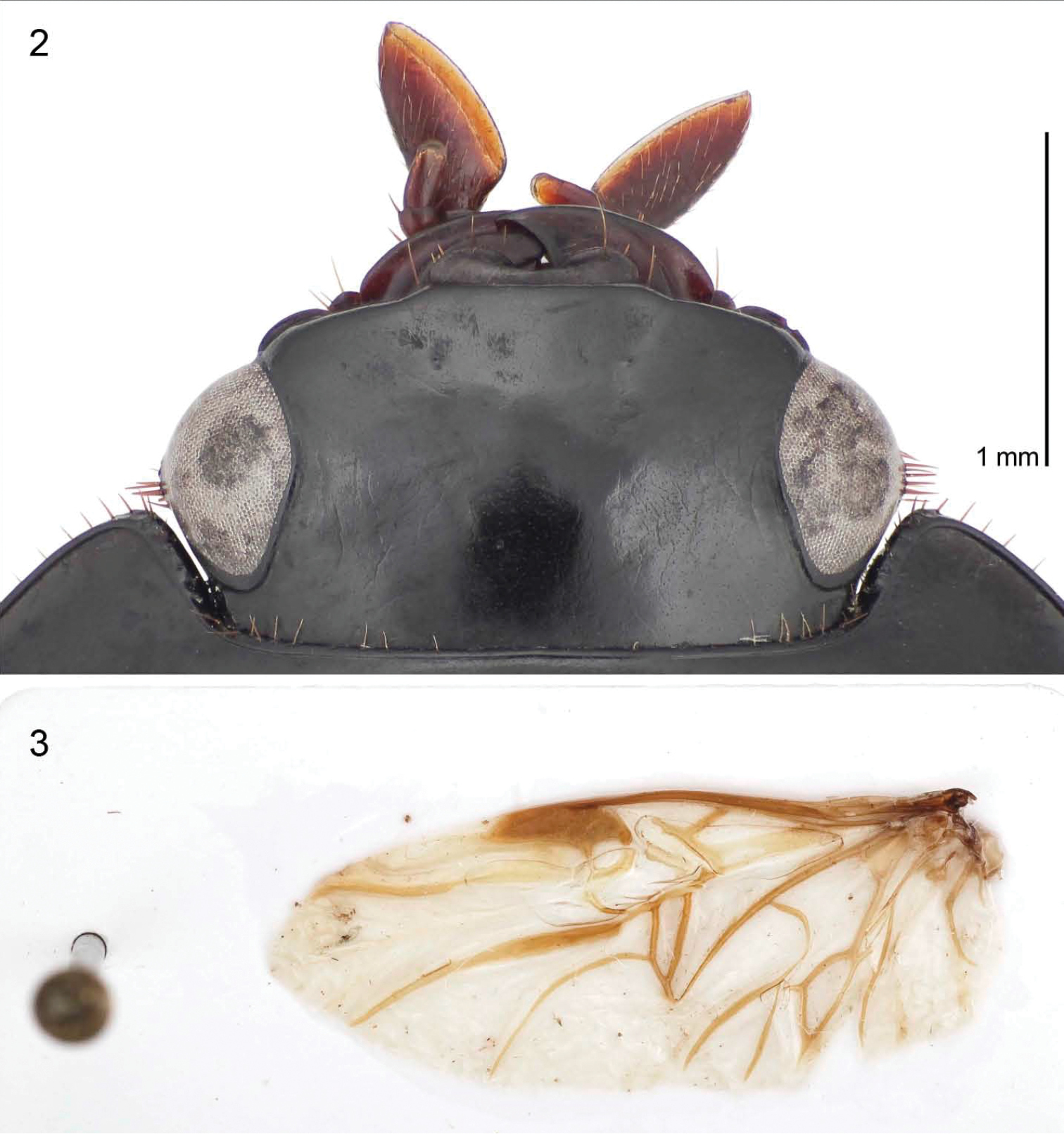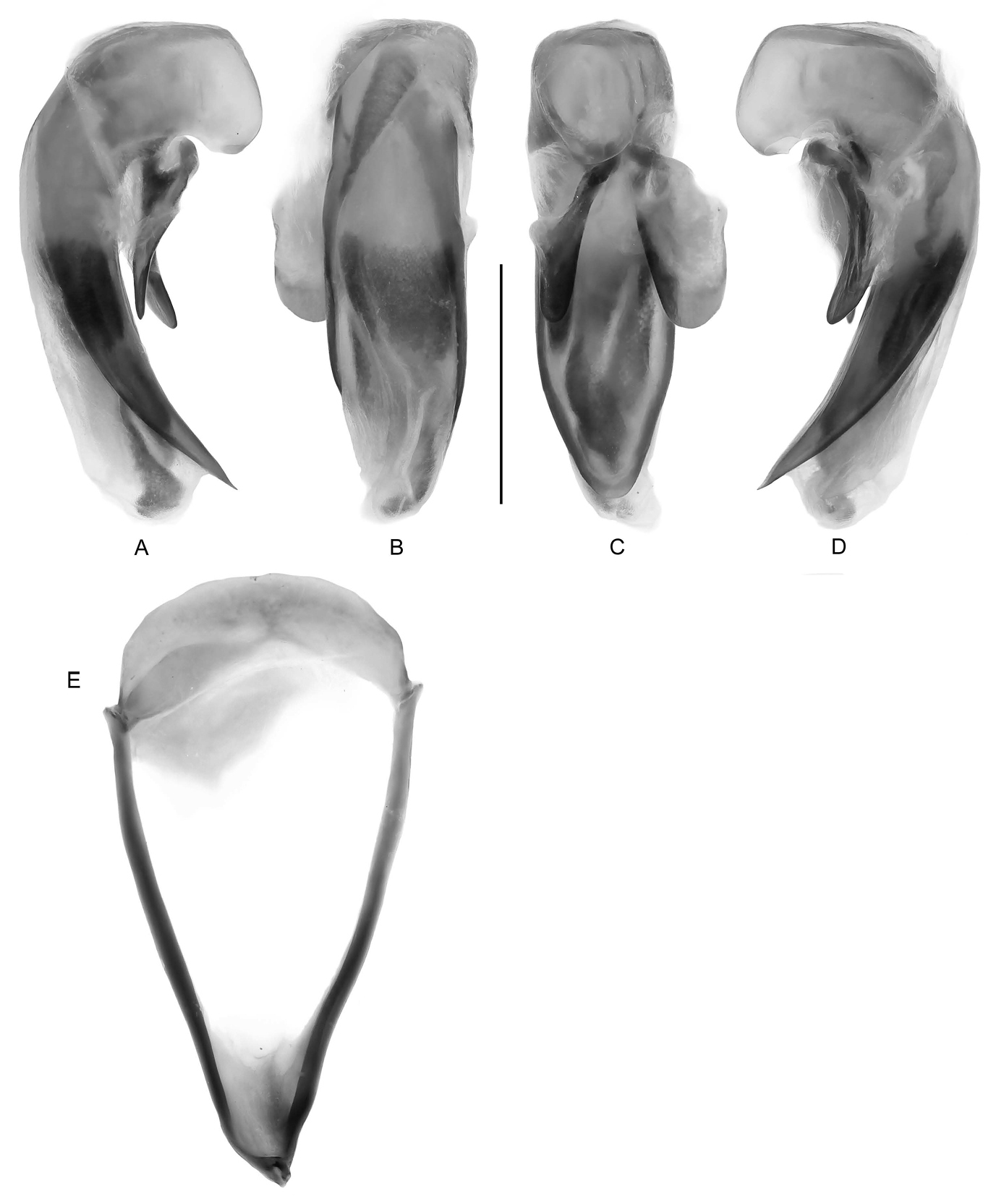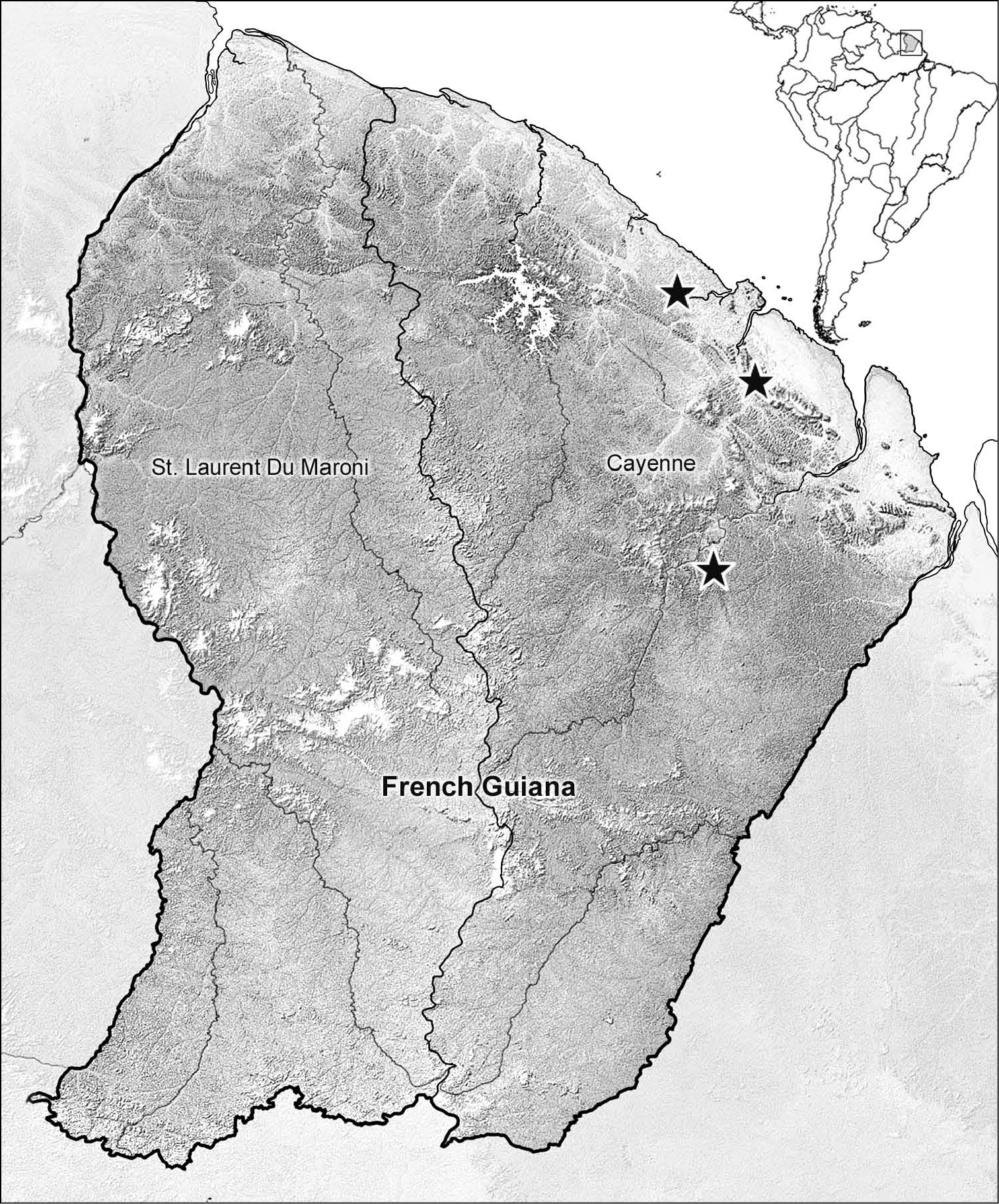






(C) 2013 Terry L. Erwin. This is an open access article distributed under the terms of the Creative Commons Attribution License 3.0 (CC-BY), which permits unrestricted use, distribution, and reproduction in any medium, provided the original author and source are credited.
For reference, use of the paginated PDF or printed version of this article is recommended.
Citation: Erwin TL (2013) Beetles that live with ants (Coleoptera, Carabidae, Pseudomorphini): A remarkable new genus and species from Guyane (French Guiana), Guyanemorpha spectabilis gen. n., sp. n. ZooKeys 358: 11–23. doi: 10.3897/zookeys.358.6298
Among the extensive collections currently being made in Guyane (French Guiana), adults of a large and colorful species of pseudomorphine were encountered. The adults present, for the first time in the Western Hemisphere, elytra with a marked color pattern, and in addition a size considerably beyond that of the rest of the members of all other known genera in the Western Hemisphere. Both of these attributes, however, are well known in the Australian pseudomorphine fauna. This new species is described and illustrated and a revised key to the Western Hemisphere genera is included. The type locality of Guyanemorpha spectabilis gen. n., sp. n. is Guyane, Risquetout, PK20, 4.916°N, 52.516°W, 12m altitude.
Entre las colecciones extensivas que actualmente se están conduciendo en Guyane (Guyana Francesa), los adultos de las especies grandes y coloridas de pseudomorfinos fueron encontrados. Los adultos presentan, por primera vez en el hemisferio occidental, élitros con un patrón colorido marcado, además de un tamaño mucho mayor que el resto de los miembros de todos los otros géneros en el hemisferio occidental. Ambos atributos, sin embargo, se conocen bastante bien en la fauna pseudomorfina de Australia. Esta nueva especie se describe e ilustra y una clave revisada para los géneros del hemisferio occidental se incluye. La localidad tipo de Guyanemorpha spectabilis gen. n., sp. n. es Guyane, Risquetout, PK20, 4.916°N, 52.516°W, altitud de 12m.
False-form beetles, identification key, distribution, male genitalia, female ovipositor, Hymenoptera: Formicidae
Surprising taxa of Carabidae continue to surface as collections from remote places and new habitats are explored (e.g.,
Guyanemorpha spectabilis sp. n., female holotype, ADP132101; Risquetout, PK20, Guyane. Habitus and female genital tract glued to card, dorsal aspect, ABL = 13.2mm.
Included in this study are a total of 4 specimens from other institutions and private collections (Appendix 1). “Methods and species concepts follow those previously described (
“Habitus and attribute images of the adult beetles portray most of the character states referred to in the key provided. Male and female genitalic presentations are standard for descriptive taxonomy of carabid beetles, and in this case are digital photo-illustrations (
“Geographical data are presented based on all known specimens of each species available at the time of manuscript preparation. Georeferences have been determined from locality information provided on specimen labels. Latitude and longitude are reported in decimal degrees. A distribution map is provided for the species [Fig. 5]. Here, an English vernacular name is proposed, as vernacular names are becoming increasingly needed in conservation and/or agricultural and forestry applications, as well as for the Encyclopedia of Life (www.eol.org), ” (Erwin and Amundson in press).
Guyanemorpha Erwin, gen. n. Guyane (French Guiana)
Manumorpha Erwin & Geraci, 2008. Brazil, Ecuador, Guyane, Perú
Notopseudomorpha (Baehr, 1997). Middle and South America
Pseudomorpha (s. str.) Kirby, 1825. USA south to Argentina (incl. Caribbean islands)
Samiriamorpha Erwin & Geraci, 2008. Perú
Tuxtlamorpha Erwin & Geraci, 2008. México, Honduras
Yasunimorpha Erwin & Geraci, 2008. Ecuador
| 1 | Mouthparts not visible in dorsal aspect. Preocular lobe absent | 2 |
| 1’ | Mouthparts visible in dorsal aspect. Preocular lobe present | 3 |
| 2(1) | Dorsal surface glabrous, markedly shiny | Notopseudomorpha (Baehr, 1997) |
| 2’ | Dorsal surface finely setiferous, not shiny | Samiriamorpha Erwin & Geraci, 2008 |
| 3(1’) | Elytron with only scutellar and ombilicate setae; with elytra markedly tapered to apex | 4 |
| 3’ | Elytron multisetiferous; body form rather broad and subdepressed with elytra not or barely tapered to broadly round apex | 5 |
| 4(3’) | Body form narrow, somewhat cylindrical | Yasunimorpha Erwin & Geraci, 2008 |
| 4’ | Body form very broad, not cylindrical | Guyanemorpha gen. n. |
| 5(3) | Dorsal surface with dense vestiture, of very long thick erect setae equal in length at least to basal 4 antennomeres, but no pubescence; body form subconvex, elytra tapered posteriorly | Manumorpha Erwin & Geraci, 2008 |
| 5’ | Dorsal surface with sparse or no long vestiture, longer setae equal in length only to at most basal 3 antennomeres, also usually with short pubescence; body form subconvex, elytra slightly tapered posteriorly or not | 6 |
| 6(5’) | Major setae of dorsal surface erect or slightly curved posteriorly | Pseudomorpha Kirby, 1825 |
| 6’ | Major setae of elytra posteriorly directed and markedly decumbent | Tuxtlamorpha Erwin & Geraci, 2008 |
http://species-id.net/wiki/Pseudomorphini
False-form beetles.
Stable at the generic level.
According to
Guyanemorpha spectabilis Erwin, sp. n.
Guyane False-form beetles
Probably Notopseudomorpha (Baehr, 1997) (see
Head (Fig. 2) without supraorbital setigerous punctures, nor any accessory setae; frontal impressions absent. Labrum barely visible with anterior margin shallowly emarginate, quadrisetose; clypeus markedly wide, nearly obscured in dorsal aspect by protruding frons, with obtuse setiferous lateral corners. Eyes slightly convex; small gena with numerous stout setae. Antenna short, just reaching anterior coxa in repose; antennomeres 3-9 slightly wider than 1-3, and appearing slightly flattened. Mandible markedly flattened with a very short and acute apex; outer margin ventral of the scrobe without short stout setae. Maxillary palpi markedly short, 3-segmented, palpomeres slightly depressed, palpomere 3 truncate apically. Labial palpus with short bisetose palpomere 2; palpomere 3 markedly securiform and robust, its distal margin mostly membranous with sensory organs.
2 Guyanemorpha spectabilis sp. n., female holotype, ADP132101; Risquetout, PK20, Guyane. Head, dorsal planar aspect 3 Guyanemorpha spectabilis sp. n., female paratype, ADP132105; Nouragues, Saut Pararé, Guyane. Left flight wing, dorsal aspect.
Prothorax. Pronotum (Fig. 1) much wider than head, transverse, with narrowly beaded margins; without a pair of setigerous punctures each side, apical, lateral and posterior margins with fringe of short stout setae; hind angles obtuse, broadly rounded. Prosternal process unisetiferous subapically, intercoxal process feebly beaded.
Pterothorax. Metepisternum elongate and markedly narrowed posteriorly, the outer margin about 2 times greater in length than the anterior margin, posterior margin about 0.2 times anterior margin.
Elytra. Elytron (Fig. 1) tapered, markedly narrower apically, width of elytra about equal to that of pronotum at widest point, apical margin truncate with evenly rounded humerus, interneurs and intervals effaced; parascutellar stria absent, scutellum hidden, parascutellar puncture present, marked; without fixed discal setae, surface glabrous. Lateral marginal (umbilical) series of 10 setae, arrayed throughout and widely spaced; lateral margin with fringe of short stout setae.
Hind wings. Macropterous. Venation (Fig. 3).
Legs. Short and depressed, femur posteriorly channeled for reception of tibia in repose; antennal comb notch very shallow; tibial spurs normal; anterior tarsi of male with tarsomeres 2–4 dilated slightly, ventrally each with two laterally placed rows of adhesive articulo-setae.
Abdomen. Abdominal sterna III–VII with patches of short setae and each of IV–VII with a single row of erect ambulatory setae numbering 2 to 8 setae; V and VI in male each with dense row of yellowish robust setae separated medially.
Male genitalia (Fig. 4). Phallobase hooded with small orifice, dorsum not crested; phalloshaft arched throughout its length, diameter sub-rounded to somewhat depressed dorso-ventrally; phalloapex produced, sharp, rounded, markedly depressed dorso-ventrally; endophallus orifice elongate, endophallus with dense patches of microtrichia. Parameres (C) moderately short compared to those of genus Pseudomorpha, nearly equal in length, left slightly longer and much broader than right, each apically glabrous. Ring sclerite (E) normal for family.
Guyanemorpha spectabilis sp. n., male paratype, ADP132103; Risquetout, PK20, Guyane. Male genitalia, median lobe and parameres labeled as in repose in male A ventral aspect B right lateral aspect C left lateral aspect D dorsal aspect.
Female ovipositor and genital tract (Fig. 1). Gonocoxite 2 falcate, base about as long as blade, latter relatively short, pointed distally; margins without ensiform setae; with short preapical nematiform seta.
http://zoobank.org/B86F564C-10FD-43CD-B257-DDE8425CF0D7
http://species-id.net/wiki/Guyanemorpha_spectabilis
Figures 1–5Guyane (French Guiana): Risquetout, PK20, 4.916°N, 52.516°W, 12m, 13 December 2010 (SEAG) (NMNH, held in trust, see below: ADP132101, female). Paratypes are listed below under other specimens examined.
The epithet “spectabilis” is a Latin adjective describing the very large and colorful beetle species.
Spectacular Guyane False-form beetle.
With the attributes of the genus as described above and color black and rufous with elytral spots (Fig. 1), color tone of head and pronotum uniform black; form broad and stout with tapered elytra; head with preapical lobe prominent but hidden in dorsal aspect beneath the frons, about 2/3 the length of the anterior margin of eye; pronotum (Fig. 1) coequal at base to elytra across humeri; elytron markedly tapered from humerus to narrower truncated apex and without interneurs or intervals, surface glabrous except parascutellar seta and 8 ombilicate setae near lateral margin.
(Figs 1, 2, 3, 4; Appendix 3). Size: Very large for a Western Hemisphere species, ABL = 13.18 to 13.51 mm, SBL = 11.05 to 12.18 mm, TW = 6.36 to 6.86 mm. Preocular lobe-eye ratio (L/L): 0.49 to 0.54. Pronotum ratio (L/W): 1.99 to 2.16. Pronotum ratio (W/L): 2.20 to 2.29. As described for genus above and the diagnosis.
These beetles are macropterous and have been recorded from flight intercept traps (FITs), hence fully capable of flight; they are likely swift and agile runners as other species in the Tribe. Accordingly, this species may be expected to be more broadly distributed across a wider geographical range than current records indicate.
Adults of other pseudomorphines in the Western Hemisphere are found in ant nests and the surrounding vicinity and possibly in termite nests (
Guyane: Réserve Trésor, 4.610°N, 52.279°W, 225m, 11 July 2009 (S. Brule) (BMNH, ADP124772, male paratype); Risquetout, PK20, 4.916°N, 52.516°W, 12m, 13 December 2010 (J.L. Giuglaris) (MNHP: ADP132103); Nouragues, Saut Pararé, 4.02°N, 52.41°W, 51m, 14 July 2010 (SEAG) (MNHP, ADP132105, female paratype).
(Fig. 5). This species is currently known only from Guyane.
Distribution dot map for known localities of Guyanemorpha spectabilis sp. n.
The holotype is currently held in trust at the National Museum of Natural History, Smithsonian Institution, Washington, DC until the planned Natural History Museum of Guyane is established, and at that time the specimen will be transferred there. See details of SEAG carabid collections in
Adults of Guyanemorpha share attributes with those of both Notopseudomorpha (Baehr) and Yasunimorpha Erwin & Geraci. This surprising large and colorful pseudomorphine came as a shock to the author, as all other species of the Tribe in the Western Hemisphere are quite dull fulvous, rufous, or black with no, or little, color contrast on the dorsal surface. Since little in the way of life information is available for the four specimens reported herein except seasonality of adult activity and lowland habitation, only speculation based on fogging samples in Perú and Ecuador can add much to this conclusion. “The pseudomorphines are a very interesting evolutionary off-shoot of the normal carabid morphotype in both form and function and are only just now beginning to be understood in North America. The fact that species of related genera in South America are living with arboreal ants will make learning about them far more difficult. Insecticidal fogging gets adults of these species, but only tearing apart arboreal Azteca ant nests while suspended in a tree will produce their larvae, and that is not for carabidologists faint of heart.” Erwin and Amundson (in press).
In addition to the museum curators and collection managers noted in Appendix 1, we also extend hearty thanks to Charyn Micheli for the Resumen and friendly review of the manuscript, and Karolyn Darrow for the images and review of the Figure Captions (both of the Department of Entomology at the Smithsonian Institution).
Institutions and personnel who loaned specimens for this revision.
BMNH Maxwell V. L. Barclay, Curator and Collection Manager, Entomology: Coleoptera & Hemiptera, Department of Life Sciences, Natural History Museum, London SW7 5BD
SEAG S. Brule, J.L. Giuglaris, The Entomological Society Antilles-Guyane, stephanebrule973@hotmail.fr
Measurements and ratios for Guyanemorpha spectabilis sp. n., all measurements are in millimeters.
| Total length (sbl) | |||||
| Males | Females | ||||
| N | Range | Mean | N | Range | Mean |
| 2 | 12.079–12.135 | 12.107 | 2 | 11.053–12.185 | 11.844 |
| Maximum width (tw) | |||||
| Males | Females | ||||
| N | Range | Mean | N | Range | Mean |
| 2 | 6.356–6.378 | 6.367 | 2 | 6.41–6.864 | 6.637 |
| W of head/w of left elytron | |||||
| Males | Females | ||||
| N | Range | Mean | N | Range | Mean |
| 2 | 1.041–1.069 | 1.055 | 2 | 0.980–0.991 | 0.986 |
| Pronotum: width (at widest part)/length | |||||
| Males | Females | ||||
| N | Range | Mean | N | Range | Mean |
| 2 | 2.193–2.220 | 2.207 | 2 | 2.253–2.327 | 2.29 |
| Length of pronotum / length of head | |||||
| Males | Females | ||||
| N | Range | Mean | N | Range | Mean |
| 2 | 1.959–2.027 | 1.993 | 2 | 2.040–2.285 | 2.163 |
| Apparent body length (abl) | |||||
| Males | Females | ||||
| N | Range | Mean | N | Range | Mean |
| 2 | 13.510–14.480 | 13.995 | 2 | 13.180–14.180 | 13.68 |
| Pre-ocular length / eye length | |||||
| Males | Females | ||||
| N | Range | Mean | N | Range | Mean |
| 2 | 0.435–0.554 | 0.494 | 2 | 0.520–0.551 | 0.535 |



